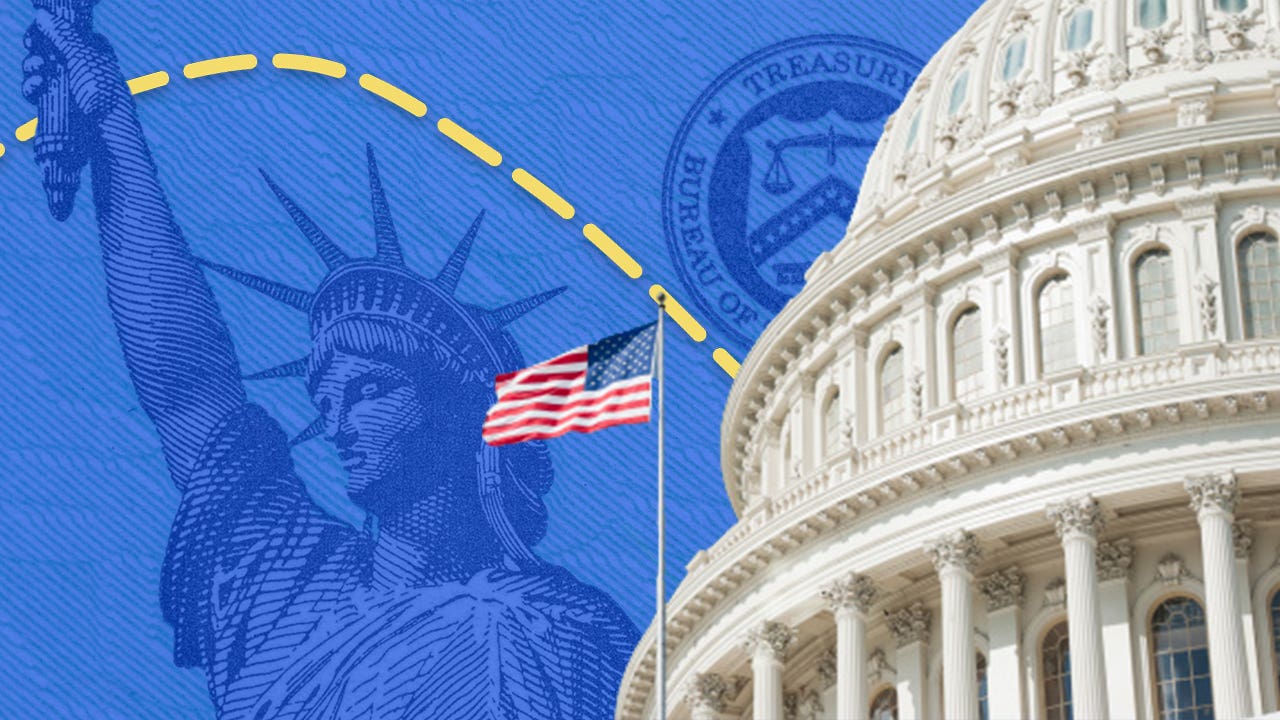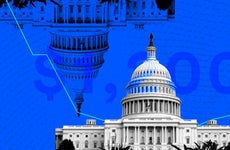Survey: More than 6 in 10 Americans say $1,400 stimulus checks won’t last three full months

The Bankrate promise
At Bankrate we strive to help you make smarter financial decisions. While we adhere to strict , this post may contain references to products from our partners. Here's an explanation for .
Even as the U.S. economy shifts its rebound from the coronavirus pandemic into high gear, Americans are still needing all the help they can get with bills and everyday essentials, according to Bankrate’s latest nationwide poll.
Underscoring the outbreak’s lingering financial burden, two-thirds (or 67 percent) of Americans receiving a third coronavirus stimulus check worth $1,400 per every adult and dependent in their household say the payment is important to their near-term financial situation. That total includes 40 percent who say the relief check will be very important and another 27 percent who say the payment is somewhat important.
At the same time, more than 6 in 10 U.S. adults (or 61 percent) say the stimulus money won’t sustain their financial well-being for more than three months, as most plan to allocate proceeds toward covering monthly bills (45 percent), daily necessities such as food and supplies (36 percent) and outstanding debt (32 percent).
At issue is the vibrancy of the U.S. economic rebound, with hiring and growth expected to ramp up over the next few months thanks to almost $3 trillion in federal spending so far this year. A substantial consumer base saddled with outstanding debt and hardship could soften the post-pandemic spending boom many firms are waiting on, nearly a year after the outbreak wiped out firms’ profits and 22.2 million jobs.
“Stimulus continues to be a bit of a misnomer, with households predominantly using the money to pay monthly bills and provide day-to-day essentials,” says Greg McBride, CFA, Bankrate chief financial analyst. “Even households with those bases covered are opting to pay down debt and boost savings – prudent decisions that lead to more sustained spending in the future.”
Key takeaways:
- Nearly 61 percent say stimulus money won’t sustain their financial well-being for more than three months, with the largest group (26 percent) expecting funds to last between one to less than three months.
- While most Americans plan to funnel stimulus money toward bills and necessities (45 percent and 36 percent, respectively), just 13 percent plan to spend checks on non-essential items.
- Almost 2 in 3 U.S. adults eligible for a stimulus check (or 67 percent) say the third round of coronavirus relief payments are important to their finances.
- Women, minorities, low-income adults and mid-career Americans are among the demographics regarding stimulus funds as most important.
How long will stimulus funds last? Most (61 percent) say less than three months
While nearly 61 percent of Americans report that the third stimulus check will sustain their financial well-being for less than three months, many Americans have a more dire financial situation, Bankrate’s poll found.
Making up that group are 21 percent of Americans who say stimulus funds won’t keep them going a full month and another 14 percent who say the check won’t prop up their wallets at all.
That’s only partially more optimistic than the late March 2020 iteration of Bankrate’s survey, which polled Americans on the heels of the first stimulus check worth $1,200 per every eligible U.S. adult and their child dependents. In that survey period, 23 percent said the payment wouldn’t last them a full month, while 8 percent said it wouldn’t sustain them at all.
But it’s considerably more upbeat than the January 2021 iteration of Bankrate’s poll, which was administered on the heels of the second stimulus check worth $600, the smallest relief payment of the three. More than a third (34 percent) of respondents said the payment wouldn’t last them a full month and another 18 percent said the check wouldn’t keep them going at all, the worst of any survey period and likely reflecting a stimulus check more than half the size of the $1,400 payment.
When it comes to Bankrate’s latest stimulus poll, 26 percent say the third Economic Impact Payment (EIP) will last somewhere between one month to less than three months, the largest time-period cluster.
Generation Xers (39 percent) and younger baby boomers (37 percent) were most likely to say the money would not sustain their financial well-being for one month, though every age group had at least 30 percent of respondents expecting funds to last less than this length of time. Hispanic respondents (at 41 percent) were more likely than any other demographic to expect the stimulus funds to last less than one month.
How Americans plan to spend relief checks
Most Americans are planning to put their stimulus funds to work covering essential expenses, such as their monthly bills (45 percent), day-to-day necessities such as food or supplies (36 percent) or paying down debt (32 percent). A marginal amount of Americans plan to invest those funds or donate them to charity (11 percent and 7 percent respectively).
Just 6 percent said they didn’t know yet where to allocate those funds, while 10 percent marked “other.”
Perhaps even more challenging for the economy, just 13 percent of Americans plan to use their stimulus checks to cover discretionary purchases, from dining out and shopping to taking a vacation. That is, however, the largest of any survey period, with just 8 percent in both January 2021 and March 2020 saying they planned to make non-discretionary purchases with their stimulus funds.
“For all the talk of revenge spending and pent-up demand for travel, you wouldn’t know it by seeing just 13 percent of stimulus check recipients indicating that any of the money would be spent on discretionary activities or non-essential items,” McBride says.
Another 28 percent say they plan to add those funds to their savings. That could perhaps open the door to more discretionary spending when the economy is fully reopened and vaccinations are in arms, though some economists aren’t convinced that behavior will be broadly shared.
At the heart of the differences in spending patterns is a diverging economic recovery. Affluent households that own assets and work in predominantly white-collar, remote work-friendly industries have thrived during the pandemic, bolstered by a booming stock and housing market. Low-income households whose incomes come from service-sector positions have been living a different coronavirus recession experience. A September 2020 research study from Opportunity Insights showed that those earning at least $60,000 a year fully recovered their jobs by mid-June of 2020. Employment in the lowest-paying jobs, however, is about 20 percent below its pre-pandemic level, a separate Federal Reserve report from February found.
“We know that people who make less money tend to spend a higher share of their stimulus checks as opposed to saving it,” says John Leer, economist at Morning Consult. “So in all likelihood, it’s the people who need the stimulus money the least who will have money leftover to help them [when the economy reopens].”
Americans’ plans for their stimulus checks depend on how much money they make. An overwhelming majority of those earning under $30,000 annually (56 percent) say they’re going to put the funds toward monthly bills, while another 48 percent of the cohort say they plan to put the stimulus money toward day-to-day essentials.
That income bracket was also the least likely of any bunch to add the relief payments to their savings, at 19 percent. Meanwhile, 31 percent of Americans making $80,000 and over a year plan to park their cash in a savings account.
Women were more likely than men to use the money to pay monthly bills (49 percent versus 41 percent) or for day-to-day essentials (40 percent compared with 32 percent). Men, on the other hand, were more likely to pay down debt (37 percent versus 29 percent) and were more than twice as likely to plan to invest their funds (15 percent against 7 percent of women).
How important the third coronavirus relief payment is to Americans’ finances
The share of Americans deeming stimulus checks important to their individual financial situation (67 percent) has improved nearly a year into the devastating outbreak, but is still stubbornly high.
In March of 2020, 80 percent of eligible adults said the first payment worth $1,200 would be important to their wallet, while 71 percent said the same the following January when the second check worth $600 went out to eligible U.S. adults and their child dependents.
Those most likely to call stimulus checks important include women, minorities and low-income workers
Women (70 percent) were more likely than men (63 percent) to say the stimulus payment is important to their financial well-being. When it comes to age groups, 72 percent of Generation X (those between the ages of 41 and 56) described the checks as essential to their wallet, the largest of any age group.
Notably, those among the highest earning households ($80,000 or more annually) are also feeling the impact of the pandemic, with nearly half (48 percent) saying the stimulus money is important to their near-term financial situation. But lower-income individuals by far overshadow those statistics, with 84 percent of those earning less than $30,000 annually, 77 percent of those earning $30,000-$49,999 annually and 65 percent of those earning $50,000-$79,999 annually saying the same.
A larger share of Americans, however, are describing the latest round of relief checks as being not very important (17 percent) or not at all important (13 percent) compared with previous iterations. Just 15 percent and 10 percent, respectively, had said the same back in January 2021, along with 12 percent and 5 percent from the survey conducted a year ago.
That might be for more bad reasons than good. The $1.9 trillion American Rescue Plan offered hard-hit Americans support, including by expanding the Child Tax Credit (CTC) and jobless benefits. But that money is no panacea and only meant to be a band-aid. The most sustainable driver of a full post-pandemic recovery will be robust job creation, Leer says.
“We have to be real with ourselves that ultimately, the strength of the consumer depends on the strength of employment over long enough periods of time,” Leer says.
How to maximize your stimulus funds
The U.S. economy has come a long way since the coronavirus pandemic first wreaked havoc on the financial system, but economists are underscoring that the path forward is still in uncharted territory. Now’s the time to take charge of your finances, maximizing any stimulus funds you receive and continuing to focus on scaling up your emergency fund in case of any future hardship.
- Reach out to lenders: If you’re dealing with a loss of income and have any outstanding debt obligations, from a mortgage payment to student loans, it’s important to reach out to those firms and negotiate for better terms, according to Marcy Keckler, CFP, vice president of Financial Advice Strategy at Ameriprise. That could be arranging a forbearance program or even working to score a lower interest rate. And word to the wise: Document all communications, and keep them in writing if you can.“You may wind up talking to someone different in a future conversation, so having that record can frankly reduce your stress but also strengthen your case that you were handling it responsibly,” Keckler says. “You certainly aren’t going to get that relief and flexibility if you don’t reach out and ask for it.”
- Build an emergency fund: Park the cash in a liquid and accessible product, such as a high-yield savings account. You can still find competitive rates and an account that fits your needs by shopping around.
- Cut back on spending: That could be as simple as limiting your non-essential spending. If you’re a homeowner, it could also be refinancing your mortgage to shave dollars off your monthly payment. If you’re carrying high-cost credit card debt, check if a balance transfer card is right for you. It all starts with finding a plan.
“Especially important now is to really get your arms around your spending,” Keckler says. “Having that financial plan and understanding your own risk tolerance – those important steps in your financial life can help you feel well-prepared to weather any changes that might come, expected or unexpected, in the markets and economy in the future.”
Methodology
Bankrate.com commissioned YouGov Plc to conduct a consumer survey. Total sample size was 2626 adults, among whom 1794 had received or were expecting to receive stimulus funds. Fieldwork was undertaken on March 24-26, 2021. The survey was carried out online and meets rigorous quality standards. It employed a non probability-based sample using both quotas upfront during collection and then a weighting scheme on the back end designed and proven to provide nationally representative results.
Related Articles

Survey: 2 out of 5 Americans aren’t ready for next recession

Survey: Most Americans plan to steer clear of shopping debt this holiday season

Survey: 57% of Americans want more coronavirus financial relief from government

Survey: 31% of Americans expecting a stimulus check say it won’t keep them going a month